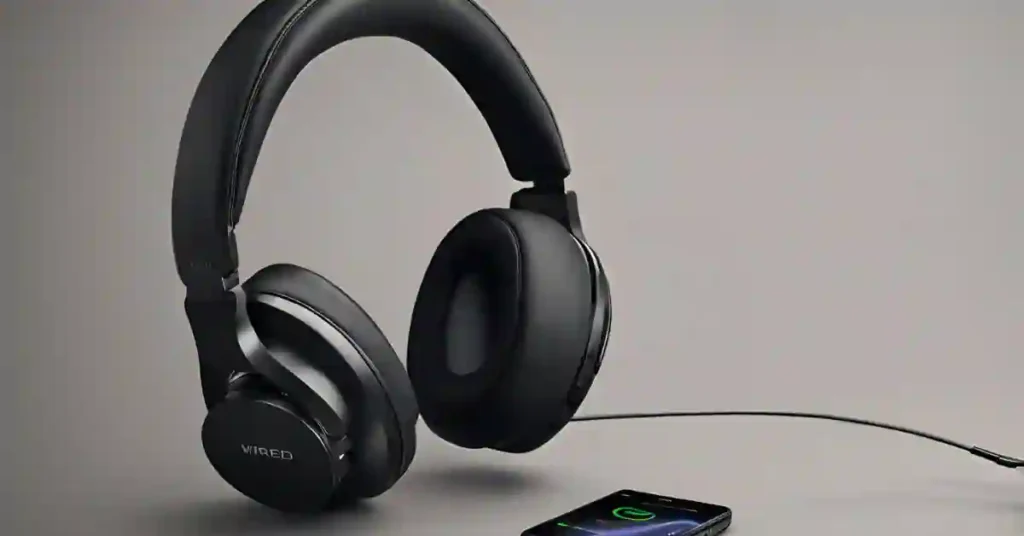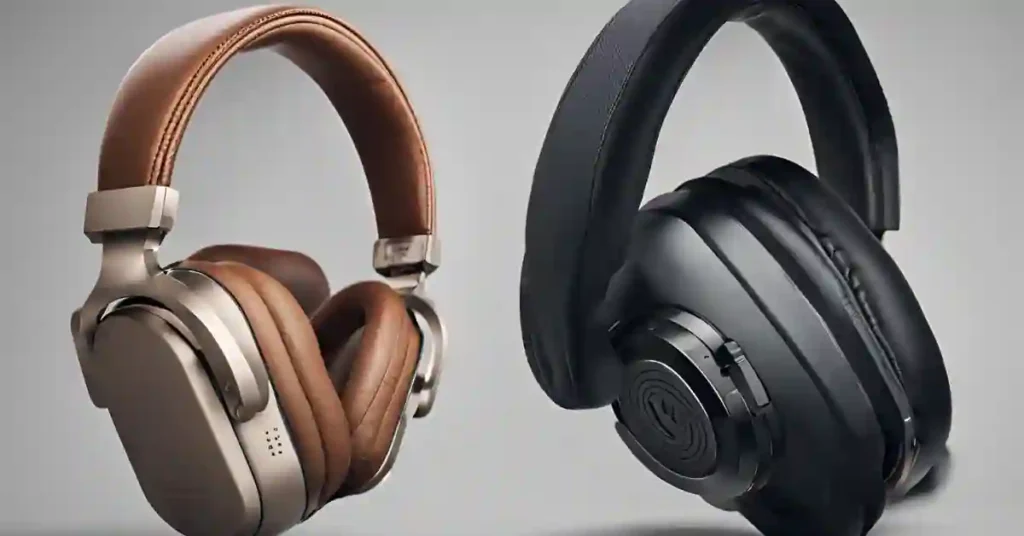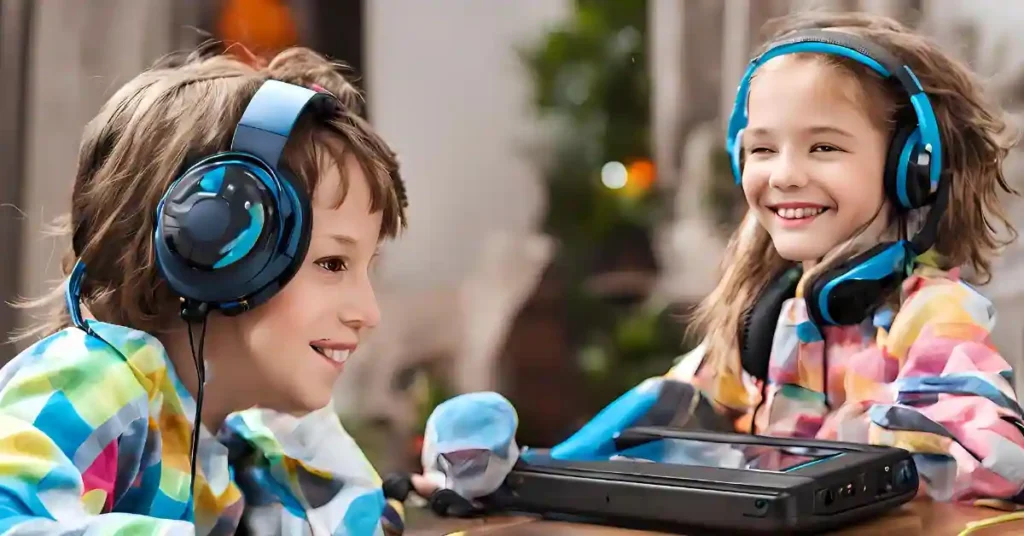Imagine you’re shopping for kids’ headphones online, about to click “buy.” But then, a question pops up – Wireless vs. Wired Which Kids Headphones Are Better? It’s a common dilemma for parents like you.
On one side, you have the classic wired headphones. They’re reliable, with a cord for a direct connection and good sound quality. On the other side, there are wireless headphones. They’re cord-free and convenient, but you need to charge them.
It’s like choosing between the new and the old. Do you stick with what you know or try something different? The decision feels important because it affects how your child enjoys their music and shows.
Don’t worry! We will be here to help you decide, and also We’ll explain the good and bad points of wired and wireless headphones so that you can pick the best headphones for your child. Let’s ensure your little one can listen to their favorite tunes comfortably and in style.
Ready for the big kid’s headphone battle? Let’s find out which one wins – wired or wireless!
Wireless vs. Wired: Pros and Cons
Now that we’ve explored the key features and considerations, let’s dive deeper into the pros and cons of wireless and wired headphones for children.

Wireless Headphones
| Pros | Cons |
|---|---|
| ✔ Improved mobility and freedom of movement ✔ Reduced risk of tangling and tripping ✔ Seamless Bluetooth connectivity ✔ Convenient for active children | ❌ Potential for inconsistent audio quality ❌ Reliance on battery life ❌ Generally more expensive than wired ❌ Potential compatibility issues with older devices |
Wired Headphones
| Pros | Cons |
|---|---|
| ✔ Superior sound quality ✔ Reliable and consistent performance ✔ Compatibility with a wide range of devices ✔ Generally more affordable than wireless options | ❌ Restricted mobility and movement due to the cord ❌ Increased risk of tangling and tripping ❌ Potential for cord damage or wear and tear over time |
Wireless vs. Wired Which Kids Headphones Are Better?
In the ever-evolving world of technology, the debate between wireless and wired headphones has been a topic of discussion for quite some time.
When it comes to choosing the right headphones for your kids, between Wireless vs. Wired, there are several factors to consider to ensure they have a safe and enjoyable listening experience.
Let’s delve into the comparison of wireless and wired kids’ headphones to help you make an informed decision.
Volume Limiting: A Critical Safety Feature

One of the most important considerations when choosing headphones for children is the ability to limit the maximum volume output. Exposure to prolonged or excessive noise can lead to hearing damage, and children’s ears are particularly vulnerable to this risk.
Both wired and wireless headphones can be equipped with volume-limiting features, which cap the maximum volume at a safe level, typically around 85 decibels (dB). This ensures that even if a child tries to turn the volume up to the maximum, the headphones will not exceed the recommended safe listening levels.
When selecting kids’ headphones, it’s crucial to look for models that advertise their volume-limiting capabilities and meet the necessary safety standards. This feature is essential for protecting your child’s hearing and promoting healthy listening habits.
Sound Quality: Wired Headphones Reign Supreme

One of the key factors to consider when choosing headphones for kids is sound quality. Wired headphones traditionally offer better sound quality compared to wireless ones. This is because wired headphones have a direct connection to the audio source, resulting in a more stable and consistent sound output.
The reason for this is that wired headphones transmit the audio signal directly through the cable, without any interference or compression. This allows for a higher bitrate and a more accurate representation of the original audio. In contrast, wireless headphones rely on Bluetooth technology to transmit the audio signal, which can sometimes lead to audio lag or interference, affecting the overall sound quality.
Additionally, wired headphones are less susceptible to signal degradation, which can occur due to obstacles or distance between the audio source and the headphones. This ensures a more consistent and reliable listening experience for your kids.
However, it’s important to note that the sound quality of wireless headphones has improved significantly in recent years, with advancements in Bluetooth technology and the introduction of higher-quality codecs, such as aptX and LDAC.
These codecs can provide a more robust and higher-quality audio transmission, narrowing the gap between wired and wireless headphones.
Ultimately, if sound quality is your top priority, wired headphones may still have a slight edge over their wireless counterparts.
However the difference in sound quality may not be as significant as it once was, and it’s essential to consider other factors, such as convenience and safety when making your decision.
Latency and Reliability: Wired Headphones Have the Edge

Another key consideration is latency and reliability. Wired headphones have a direct, physical connection to the audio source, which means there is virtually no lag or delay in the audio playback. This is crucial for activities like gaming, where even a slight delay can be disruptive to the experience.
Wireless headphones, on the other hand, rely on Bluetooth or other wireless protocols, which can sometimes introduce latency issues, especially in environments with a lot of interference or when the distance between the headphones and the audio source is too great.
This can be particularly problematic for fast-paced games or for watching videos, where lip-sync issues can be distracting.
In terms of reliability, wired headphones are generally less prone to connection dropouts or interference, as they don’t have to maintain a wireless link. This can be especially important for children, who may not always be as careful with their devices as adults.
Convenience and Mobility: Wireless Headphones Shine

Wireless headphones provide the convenience of mobility, allowing kids to move around freely without being tethered to a device. This can be particularly beneficial for active children who enjoy listening to music while playing or exercising. They can roam around the house, play in the backyard, or even go for a walk without the hassle of a cable getting in the way.
The wireless nature of these headphones also eliminates the risk of the cable getting caught on furniture or other objects, which can be a common issue with wired headphones. This can provide a safer and more enjoyable listening experience for your kids, especially in environments where they are likely to be moving around a lot.
On the other hand, wired headphones may limit mobility due to the physical connection to the audio source. This can be a drawback if your child wants to move around while listening to music or watching videos. However, the length of the cable can be adjusted to provide a reasonable range of motion, and some wired headphones come with longer cables to accommodate more active use.
Another advantage of wireless headphones is the ability to seamlessly switch between different devices, such as a smartphone, tablet, or laptop, without the need to physically unplug and reconnect the headphones. This can be particularly useful for kids who may use multiple devices throughout the day.
However, it’s important to note that wireless headphones require regular charging, which can be a potential drawback. If the battery runs out, your child may be left without a way to listen to their audio content. Wired headphones, on the other hand, do not require charging and can be used as long as they are connected to a power source.
Overall, the convenience and mobility offered by wireless headphones can be a significant advantage, especially for active kids. But it’s essential to weigh this against the potential drawbacks, such as the need for regular charging and the potential for signal interference or audio quality issues.
Safety and Durability
When it comes to kids’ headphones, safety and durability are paramount. Wired headphones are generally considered safer for younger children as they do not emit electromagnetic radiation like wireless headphones.

Wireless headphones use Bluetooth technology to transmit the audio signal, which involves the use of radio frequency (RF) waves. While the levels of RF radiation emitted by Bluetooth headphones are generally considered safe, some parents may still have concerns about the potential long-term effects on their child’s health.
Additionally, wired headphones are less likely to cause interference with other electronic devices, such as smartphones or tablets, which can be a concern with wireless headphones. This can be particularly important in a household with multiple electronic devices, where interference could disrupt the functionality of other gadgets.
In terms of durability, wired headphones are often more robust as they do not have delicate electronic components that can be damaged easily. The cable of a wired headphone can withstand more wear and tear compared to the internal components of a wireless headphone, which may be more susceptible to damage from drops, impacts, or other forms of physical stress.
Furthermore, wired headphones are less likely to be lost or misplaced, as they are physically connected to the audio source. Wireless headphones, on the other hand, can be easily misplaced or lost, which can be a concern for parents who want to ensure their child’s headphones are always available and accessible.
It’s important to note that both wired and wireless headphones can be designed with safety features, such as volume-limiting capabilities, to protect your child’s hearing.
However, wired headphones may have a slight advantage in this regard, as they are less likely to experience unexpected volume spikes or other audio-related issues that could potentially harm your child’s hearing.
Overall, when it comes to safety and durability, wired headphones may have a slight edge over their wireless counterparts. However, it’s essential to choose high-quality, well-designed headphones, regardless of the connectivity type, to ensure your child’s safety and the longevity of the product.
Comfort and Fit

consider when choosing headphones for kids. Wireless headphones are typically lighter and more comfortable to wear for extended periods compared to wired headphones, which may have bulky cables that can get tangled or cause discomfort.
The absence of a physical cable in wireless headphones can provide a more streamlined and unobtrusive listening experience, allowing your child to focus on their audio content without the distraction of a cumbersome cable. This can be particularly beneficial for kids who may be sensitive to the weight or feel of a headphone cable.
Additionally, wireless headphones often feature adjustable and padded ear cups or headbands, which can help ensure a comfortable and secure fit for your child’s head. This is important, as a proper fit can not only enhance the listening experience but also help prevent the headphones from slipping or causing discomfort during extended use.
On the other hand, wired headphones may have a more rigid design, with a fixed cable that can sometimes feel bulky or restrictive. However, some wired headphones are designed with flexible and lightweight cables that can minimize the impact on comfort and fit.
It’s worth noting that the fit of the headphones is equally important, regardless of whether they are wired or wireless. A well-fitting pair of headphones will not only provide a comfortable experience but also help to ensure that the audio is delivered effectively to your child’s ears.
When evaluating comfort and fit, it’s essential to consider factors such as the size and shape of your child’s head, the weight of the headphones, and the adjustability of the headband or ear cups. Additionally, it’s a good idea to try on different models or sizes to find the best fit for your child’s unique needs.
Overall, while wireless headphones may have a slight edge in terms of comfort due to their lightweight and cable-free design, the fit and adjustability of the headphones are equally important factors to consider when choosing the right pair for your child.
Price and Affordability
The cost is often a deciding factor when choosing between wireless and wired headphones for kids. Wireless headphones tend to be more expensive than wired ones due to the advanced technology and features they offer.
The additional components required for wireless headphones, such as Bluetooth chips, batteries, and charging circuitry, contribute to the higher price tag. Manufacturers often need to invest more in research and development to create wireless headphones that deliver a seamless and reliable user experience.
On the other hand, wired headphones are generally more affordable, as they have a simpler design and fewer electronic components. The lack of wireless connectivity and the need for a battery can make wired headphones a more cost-effective option, especially for parents on a tighter budget.
It’s important to note that the price range for both wired and wireless headphones can vary significantly, depending on the brand, features, and quality of the product. High-end wired headphones can be just as expensive as their wireless counterparts, while budget-friendly wireless options are also available.
When considering the price, it’s essential to balance the cost with the features and benefits that are most important to you and your child. While wireless headphones may offer more convenience and mobility, wired headphones can provide a more affordable solution without compromising sound quality or durability.
Additionally, it’s worth considering the long-term costs associated with each type of headphone. Wireless headphones may require periodic battery replacements or recharging, which can add to the overall cost of ownership. Wired headphones, on the other hand, may not have these ongoing expenses, making them a potentially more cost-effective choice in the long run.
Ultimately, the decision between wireless and wired headphones for your kids should not be solely based on price, but rather on a combination of factors, including sound quality, safety, comfort, and your overall budget. By carefully weighing these considerations, you can make an informed decision that provides the best value for your money and the optimal listening experience for your child.
Wireless vs. Wired: Choosing the Right Headphones for Your Child

When it comes to selecting the best headphones for your child, there is no one-size-fits-all solution. The decision ultimately depends on your child’s age, listening habits, and personal preferences, as well as your priorities and concerns as a parent.
For Younger Children (2-6 years old): Wired Headphones are Best
- Wired headphones may be the safer choice, as they are less likely to be lost or swallowed.
- Look for models like the Onanoff BuddyPhones Explore+ that have volume-limiting features and durable, child-friendly designs.
- Comfort and fit are crucial, as younger children may have smaller heads and be more sensitive to pressure or discomfort.
For Elementary School-Aged Children (6-12 years old): Both Wired and Wireless Can Be Suitable
- Both wired and wireless headphones can be suitable, depending on your child’s needs and preferences.
- Volume-limiting features are still essential, but older children may appreciate the added convenience of wireless headphones like the JLab JBuddies Play.
- Consider the child’s activities and whether the freedom of movement offered by wireless headphones would be beneficial.
For Tweens and Teens (12-16 years old): Wireless Headphones are Best
- Older children may have more specific audio preferences and may appreciate the sound quality of wired headphones.
- Wireless headphones like the Puro Sound Labs BT2200-Plus or PuroQuiet-Plus can provide a more seamless and hassle-free listening experience, especially for active or mobile activities.
- Involve your child in the decision-making process to ensure they are satisfied with the chosen headphones.
Regardless of your child’s age, it’s crucial to prioritize safety, comfort, and audio quality when selecting headphones. Carefully research the features, reviews, and safety certifications of the products to make an informed decision that will protect your child’s hearing and provide them with an enjoyable listening experience.
Some other great options to consider include:
- Altec Lansing MZX4500 (affordable wired and wireless option)
- Puro Sound Labs BT2200-Plus (wireless with volume limiting and comfort features)
- iClever Cat Ear Kids Bluetooth Headphones ( Bluetooth cat ear headphones purple, 74/85/94dB Volume Limited)
Remember, the safety of your child’s hearing is paramount. Always prioritize headphones that meet the necessary safety standards and provide the necessary features to prevent excessive noise exposure.
Also See: Best Headphones For Toddlers: Safe And Sound Listening For Little Ones
Conclusion
In conclusion, both wireless and wired headphones have their own set of advantages and disadvantages when it comes to choosing the best option for kids. While wireless headphones offer convenience and mobility, wired headphones excel in sound quality and safety.
When it comes to sound quality, wired headphones generally provide a more stable and consistent audio output, as they have a direct connection to the audio source. Wireless headphones, on the other hand, rely on Bluetooth technology, which can sometimes lead to audio lag or interference, affecting the overall sound quality.
In terms of convenience and mobility, wireless headphones allow kids to move around freely without being tethered to a device, which can be particularly beneficial for active children. Wired headphones, however, may limit mobility due to the physical connection to the audio source.
Safety and durability are also important factors to consider. Wired headphones are generally considered safer for younger children as they do not emit electromagnetic radiation like wireless headphones. Additionally, wired headphones are often more robust and less susceptible to damage compared to their wireless counterparts.
Comfort and fit are also crucial aspects, with wireless headphones typically being lighter and more comfortable to wear for extended periods. However, the fit of the headphones is equally important, regardless of the connectivity type.
Finally, the cost is often a deciding factor, with wireless headphones generally being more expensive than wired ones due to the advanced technology and features they offer.
Ultimately, the decision should be based on your child’s needs and preferences, as well as your budget constraints. Whichever type of headphones you choose, ensuring they are comfortable, safe, and durable should be a top priority to provide your kids with an enjoyable listening experience.
By considering the factors mentioned above, you can make an informed decision on whether wireless or wired headphones are better suited for your kids. Remember to prioritize safety, comfort, and sound quality to ensure your child’s listening experience is both enjoyable and beneficial.
Related :-
FAQs:- Which Headphones Are Better for Kids: Wired vs. Wireless
Q. Are wired or wireless headphones better for kids?
Selecting the ideal headphones for your child hinges on both their age and how they’ll be utilizing them. Wired headphones offer a compelling option for younger children (under 8). Their simplicity, with no need for Bluetooth pairing, makes them user-friendly. Additionally, their generally lower price point caters to budget-conscious parents. Furthermore, wired headphones tend to be more durable, withstanding the occasional bump or tug that comes with younger hands. However, the tethered nature of wired headphones can pose a tripping hazard and restrict a child’s mobility.
For older children, wireless headphones provide greater freedom of movement. Unencumbered by a cord, they can move around more freely without hindrance. Safety is also enhanced with the absence of a cord, eliminating potential strangulation hazards. Additionally, wireless headphones often boast a more modern aesthetic and may even incorporate features like built-in microphones for calls. While convenient, these headphones come with the drawbacks of requiring charging, potentially higher costs, and the occasional possibility of connection issues.
Ultimately, the optimal choice rests upon your child’s specific needs. Regardless of wired or wireless, prioritize comfort and features that safeguard your child’s hearing, such as volume-limiting capabilities.
q. How many hours per day is it safe to use earbuds?
There’s no single, definitive answer to how many hours per day it’s safe to use earbuds. It depends on the volume level you listen to. Here’s a key point to remember:
A safe listening level is generally considered to be 85 decibels (dB) or lower. This is roughly the sound of moderate traffic noise.
Here’s a guideline based on volume level:
At or below 85 dB: You can listen for several hours a day without a significant risk of hearing damage.
85-90 dB: Limit listening time to a couple of hours per day.
Above 90 dB: It’s best to limit listening to under an hour to protect your ears.
Additional factors to consider:
Your hearing: Some people are more susceptible to noise-induced hearing loss than others.
Type of earbuds: Noise-canceling earbuds can create a quieter environment overall, even at the same volume level as regular earbuds.


